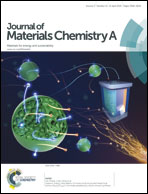A green and scalable synthesis of highly stable Ca-based sorbents for CO2 capture†
Abstract
High-temperature sorption of CO2via calcium looping is a promising technology for the implementation of carbon capture and storage (CCS). However, the rapid deactivation of CaO sorbents due to sintering is currently the major drawback of this technology. We, for the first time, report an economical and environmentally benign strategy to reduce sintering by adding fly ash, a waste stream of coal-fired plants, into Ca-based sorbents through a simple dry process. The as-synthesized sorbents were tested using a TGA and showed an extremely high stability under the most severe multi-cycle conditions (calcined at 920 °C in pure CO2). Upon 100 cycles, its CO2 capture capacity was 0.20 g(CO2) g(sorbent)−1, and the average deactivation rate was only 0.18% per cycle. The most possible stabilization mechanism was discussed on the basis of a range of characterizations including N2 physisorption, SEM, TEM (coupled with EDX mapping) and XRD; it was concluded that stable and refractory gehlenite (Ca2Al2SiO7) particles were formed and evenly dispersed around CaO crystal grains during calcination at 950 °C, leading to sintering resistance. This strategy achieved superior enhancement in the cyclic stability of Ca-based sorbents as well as the reuse of industrial solid waste, and is thus a green technology for scaled-up CO2 capture.


 Please wait while we load your content...
Please wait while we load your content...